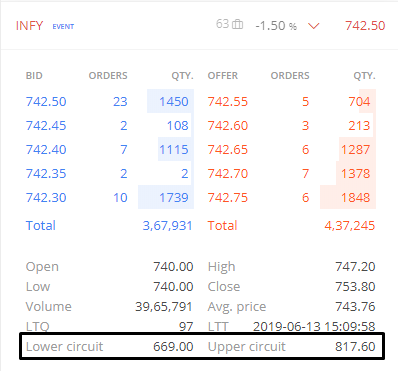Have you ever heard about the upper circuit limit in the share market? If you are interested in the share market, you may have already listened to this phrase. But do you know what the upper circuit meaning and how it works?
Here in this blog, I will explain the upper circuit, why this exists or happens, how it functions, and much more. So if you want to cover this information, stay at this particular blog and start covering all the details.
What is Circuit Limit?
SEBI or the Security Exchange Board Of India has put some limitations on the prices of stocks or shares. With the help of such limitations, SEBI can prevent any suspicious activity in the share market. It is also helpful in controlling the rise and fall of share prices to keep the stock market healthy.
The reason being, the prices of stocks increase or decrease many times just in a single trading day, and this process stays functional for every trading day.
Therefore it is essential to control such movements in share prices. There are specific benchmarks, and share prices can go upward or downward under these benchmarks on a trading day.
Because of these, the trading automatically gets suspended when share prices cross the upper or lower circuit limit. Therefore, stocks have flexible price ranges these days, and they work accordingly as per the share market.
Now you have understood circuit limit meaning and are willing to know upper circuit meaning, so let’s discuss that as well.
What is Upper Circuit Meaning?

When the stock prices reach the maximum or highest level of the circuit limit for the particular stock, it is called the upper circuit limit. In simple words, the upper circuit meaning reflects that the prices of the shares have hit the highest level of the circuit limit. When a share stays on the upper circuit limit, the trading for that stock is halted for some duration.
The upper circuit limit for any stock can be from 2 percent to 30 percent. However, in most cases, the upper circuit limit stays around 20 percent for most shares.
As this period stays for a short time, therefore, if you are a trader for such stock and willing to trade, then you should do trading quickly. However, finding the seller can be more challenging after prices reach to upper circuit limit.
So, here you understood the meaning of the upper circuit limit; let have a look at how it functions as well.
How Upper Circuit Works?
Before we start understanding the function of the upper circuit limit, we also need to know about the two commonly used terms, i.e., price range and circuit filters.
The term price range is used for the specific shares, whereas the circuit filters represent the whole indexes. So, shares have a price range, and indexes have circuit filters.
Now you have also understood that the upper circuit limit is the share price, and beyond it, the price of the stock will not increase. On the other hand, the circuit filters are applied as 5, 10, 15, and 20 percent. And when filters apply to the shares or stocks, the trading for the stock halted for a specific time. The stock trading halted for that particular stock in all the segments, whether equity or F&O (future & operations).
However, if you want to do trading during this time, you will have to book your slot. This activity is significant because it prevents massive increments in the stock prices and prevents investors from panicking.
Example:
So, to understand the upper circuit limit and its function, it is essential to look for an example. Therefore, here we will be discussing the same most simply so that you can understand.
If the stock call XYZ has the 20 percent (it is the standard upper circuit limit for most of the shares) circuit limit and its market price is Rs 1000. So, when the share prices reach the maximum level, a 20 percent circuit limit will be applicable.
And the prices for the specific shares will not increase more than their trigger price during a trading day. Here the maximum price of the share will be (share price + upper circuit limit) 1000*20% = 1200.
Also, when the prices go higher than the fixed limit, then trading for the stock will get closed for a particular time, as you already know.
Why Upper Circuit Limit Necessary?
Many of you think about why the upper circuit limit is vital in the share market. Several reasons need to look out, as mentioned below.
When the prices go higher for the particular share, the investors can panic and face loss. Therefore whenever prices reach the maximum level, UCL applies automatically.
It helps in preventing unjustified risks involved in investment and trading. And you can think better about what will happen if there are not circuit limits.
In most cases, the base prices are set upon the following days closing share prices. And generally, the circuit limit stays around 20 percent. Therefore it is essential to keep the stock market healthy.
Final Takeaway
The upper circuit limit is essential for stock trading because it prevents an unnecessary increase in any listed stock. This is exceptionally beneficial for investors and traders. They can avoid any fraud and loss due to the unstable market trend of the particular trading day.
The standard UCL starts from 20 percent and changes according to the market environment. Therefore, if you want to trade during this time, you should be clear with the concept of circuit limit in the share market. This will help you to keep your investment profitable.
I hope you have understood upper circuit meaning and are now ready to develop more understanding about stock trading. So, look for our other helpful blogs because they will help you clear other crucial concepts of the stock market.
